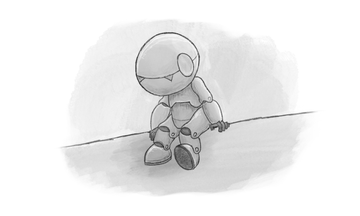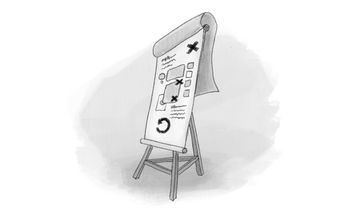Vulnerability

Being the person that transforms ideas into concrete objects is to be, lots of time, vulnerable
Building a digital product (or service) in 2022 involves, invariably, a good deal of cooperation between people.
We cooperate to understand what we build, how we build it, and find out how people would probably use the product.
We cooperate mainly to manage expectation from whom finance everything. Sometimes it is a boss, but other time is a client. Mostly both.
And this group used to have a person responsible for transforming ideas into something tangible. A person who place concepts in the form of a prototype, wireframe, map or a simulation. In other words, someone who makes concrete the outcome of cooperation. Mostly, that person is a designer, but it could also be someone managing the product or developing systems.
This is an essay about the vulnerability of people who build stuff. In this case, it’s a point of view from design (because that’s my experience), but this subject could also relate to any work with the objective of turning ideas into things.
Evaluating design
When you enter the market as a product designer, your effort ends in an object: a deliverable[1]. Your workforce results in a software interface, a barely functioning prototype or even a strategy to guide the team in constructing something. In the end, you will deliver something to someone. Even if rarely it’s the final product, the thing was built together with other people. But sometimes you get the help of none.
Design is not an exact science. That’s why, most of the time, work is not evaluated correctly. When you receive feedback, criticism or evaluation about your production, it’s also evaluated subjectively by someone.
I have a friend who always repeats: Design is a project. He is a graduate designer who speaks with more authority than I do about this subject. I like to think that, being a project, we could extrapolate to something with a purpose. That impact the world in a certain way.
Both aspects, impact and purpose, are good principles for evaluating how the design work.
The evaluation could start with why it was built. What is the point? What objective does it expect to achieve? What is it for? And we could also evaluate the consequence of the construction. How, at the end of the day, that thing is used by people. Look, even though oversimplification is a way to evaluate design work, there’s still room for personal interpretations.
Still, one requires experience with the craft to evaluate the design’s work. Even between peers, the subjective analysis comes off. Among people not used to the design method, it is even worse.
I remember a large meeting at a big company where I worked long ago. The company planned to launch a new app with an innovative service, and everybody gathered to evaluate the work. In this case, the work was done by a third company hired just for this job[2].
In that meeting, a representative presented the complete work. I remember that he was careful to show thoroughly every app feature. During a series of Powerpoint slides, each app screen was exhibited and explained. Professional work, really.
I also remember that by the end of the meeting, he proudly exhibited a working prototype on his smartphone.
In the end, I expected (naively) lots of questions from the people who would be supposed to evaluate the project execution. “Why was it done in that way?” Would people be able to use the product? The company goal will be met?
None of these questions came to the presentation. What followed was an endless discussion about the colours they used on the interface. “What if we use the brand colour here?”. “I think that button does not follow the brand book”. “I think our director would not like that screen because that’s our competitor’s colour”. These are some examples of that conversation.
It went on for hours. We did not discuss Usability. Even less accessibility. There wasn’t an MVP or a test to understand if the app was, in fact, usable. Not even to understand if our client was interested in a product like that. Nobody discussed how people would use it or the impact on the company’s financials. It was a… shallow… conversation about the project’s colour palette.
We could not even say that this was expected. We did not reserve a moment to talk about branding, for example. Ultimately, it was just a group of people judging a work by the only lens they got.
Sadly, it’s common that the design work be measured in that way. People who do not have experience in design or product processes are usually guided by personal sensations, and anecdotic evidence and often do not know bias in their opinions.
But this is not a conversation just about design.

Vulnerability is about not having ways to protect themselves. It says something about having a risk of being harmed in the face of danger.
But vulnerability is also a complex word when used in social sciences. Here, in the design context, I mean only an abridgement of the concept.
There’s no way to compare design delivery with the experience of vulnerable people in our society. Homeless people, for example, live in extreme situations of risk and scarcity.
Those who work in design are usually part of a society that doesn’t worry about not having food on the table. In urban cities, it is one of the most desired careers. There’s a scarcity of a qualified workforce and plenty of job opportunities.
Still, to present a deliverable to a team is, in a certain way, a vulnerable situation.
But it’s subtle. It’s part of the power dynamics. It’s a fragility in a relationship where the weak side is also the major contributor to the job. And, if the work does not happen as expected, there will be consequences.
Few people have the luxury of working just for the love of the practice and not because they need money at the end of the month. There’s this veiled threat. And it’s no different in the design work universe: You’ll only have a job while you can build something that the company desires. If you don’t do it, there’s no reason to be employed.
Failure is dangerous. For a lot of people who work with design, to show the perfect deliverable is, at the same time, to guarantee your work is necessary and valid, especially at the beginning of your career.
Our production has a tendency to fulfil another’s desire (who pays the salary). We usually close our eyes to work on something that won’t work or something that will make the user’s life worse.
In the end, we avoid fixing or questioning a job that could be done in a better way only to maintain the productivity image.
We even internalized that feeling, learning to never end the demand for productivity. The South Lorean philosopher Byung-Chul Han has an interesting point of view about those aspects in our contemporary society.
Vulnerability as a requirement
In a craft like design, making mistakes is fundamental for the process to follow its natural course. No wonder we have a word for that – “Iteration” – where we combine errors sequentially until success. But that doesn’t mean that making mistakes is a well-accepted habit in institutions that work with design.
It’s not uncommon to find stories of whom suffered heavy criticism when the work didn’t fulfil the expected objective in the first trials. Especially for those who recently entered this industry, it’s pretty difficult to succeed in the first attempts, and the consequence of this act could be the development of a cycle of stress and mental health illness.
As in human relationships, the capacity to make mistakes (and correct them) is fundamental for the iterative process of design work properly. In this capacity, we learn to adjust our direction, understand problems and build products and services that are more resilient. That’s no way to do that without falling from time to time.
The bare minimum that one who works with design deserves is to have an environment where being vulnerable is not a synonym for danger but professional development.
A place where the outcome of your creation could (and will) be wrong lots of time, especially in the moment of turning ideas into something concrete. It’s especially at that moment that we understand a lot of project inconsistencies.
Communication could go wrong, and your deliverable ends up being the opposite of what everyone expects. At the end of the research, we could figure out that what we needed to learn had almost no connection with what we researched. The idea could present itself as technically not viable. And all of that supposing the group communication went well from the being, which is rarely the case.
When we turn team ideas into something concrete for the first time, it is common to realize that it doesn’t work. That there’s no way to build how we previously envisioned. So, making mistakes should be expected. Besides being a learning moment, it’s a necessary step for the end-to-end design process.
Therefore, being in an environment that allows for project mistakes appropriately contributes to transforming into learning and development, something that resembles the fear of losing a job. A feeling of security and belonging is essential for designers in their early careers.
Having a safe space for vulnerability allows not only the success of the product or service but also the healthy development of the design industry (or any industry that transforms ideas into solutions).
Other references
- Don’t take design critique as an insult
- Please let me fail: failure, vulnerability and creativity
- Designing the Smallest Possible Thing
- Authenticity at work is a privilege
- Brene Brown em The power of vulnerability
There is a whole discussion about the role of designers in the corporate world and how often their work is related to convincing, teaching, guiding people in a certain direction. ↩︎
If you don’t work in the area, you may not know this, but it’s very common for large companies to hire smaller companies to build digital products. It’s usually cheaper than having a dedicated team in-house. ↩︎